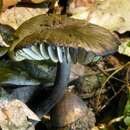fr
noms dans le fil d’Ariane


Neohygrocybe is a genus of agaric fungi in the family Hygrophoraceae. Neohygrocybe species belong to a group known as waxcaps in English, sometimes also waxy caps in North America or waxgills in New Zealand. In Europe, Neohygrocybe species are typical of waxcap grasslands, a declining habitat due to changing agricultural practices. As a result, three species, Neohygrocybe ingrata,[1] Neohygrocybe nitrata,[2] and Neohygrocybe ovina,[3] are of global conservation concern and are listed as "vulnerable" on the IUCN Red List of Threatened Species.
The genus was described by Czech mycologist Josef Herink in 1958.[4] It was formerly synonymized with Hygrocybe by many authorities,[5] but recent molecular research, based on cladistic analysis of DNA sequences, indicates that Neohygrocybe is monophyletic and forms a natural group distinct from Hygrocybe sensu stricto.[6][7]
In Europe, Neohygrocybe species are typically found in agriculturally unimproved, short-sward grasslands (including pastures and lawns).[5] Elsewhere, they are most frequently found in woodland. The genus is cosmopolitan.
{{cite journal}}: CS1 maint: multiple names: authors list (link) Neohygrocybe is a genus of agaric fungi in the family Hygrophoraceae. Neohygrocybe species belong to a group known as waxcaps in English, sometimes also waxy caps in North America or waxgills in New Zealand. In Europe, Neohygrocybe species are typical of waxcap grasslands, a declining habitat due to changing agricultural practices. As a result, three species, Neohygrocybe ingrata, Neohygrocybe nitrata, and Neohygrocybe ovina, are of global conservation concern and are listed as "vulnerable" on the IUCN Red List of Threatened Species.